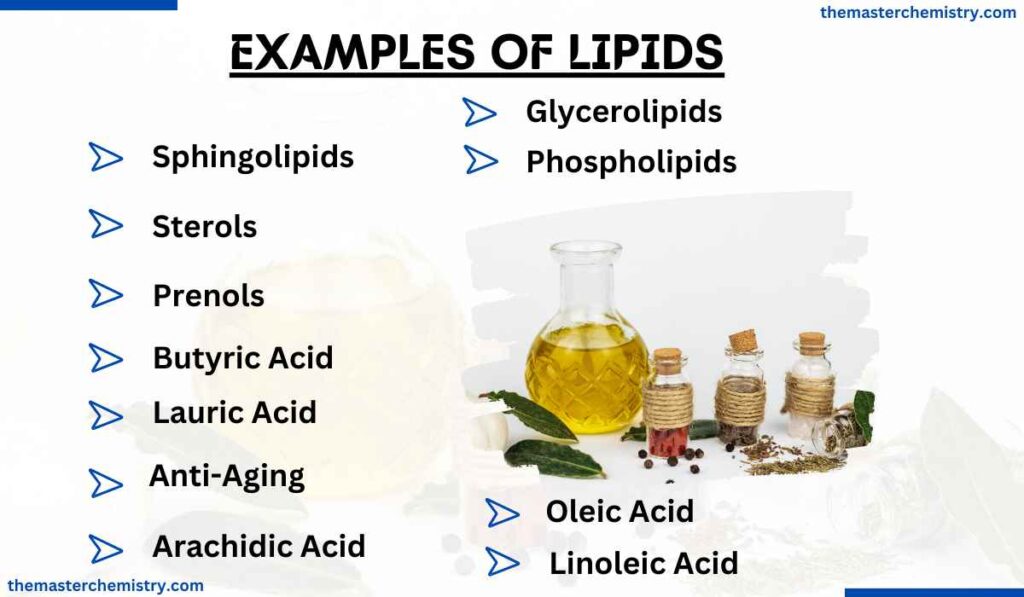Lipids are a group of naturally-occurring molecules that are insoluble in water but soluble in organic solvents. Examples of lipids include fats, waxes, sterols, triglycerides, phospholipids, sphingolipids, and glycolipids.

Common Examples of Lipids
Table of Contents
Here are some examples of Lipids :
Glycerolipids
Glycerolipids are special fats made up of glycerol and fatty acids.
Triglycerides is common example of glycrolipids. They consist of three fatty acids attached to a glycerol backbone.
Triglycerides are found in animal and plant oils and fats, and they serve as a way for organisms to store and release energy as needed.
Phospholipids
Phospholipids are essential building blocks of cell membranes. They have two parts: a “head” that loves water (hydrophilic) and a “tail” that dislikes water (hydrophobic).
These parts help form the protective barrier around cells.
Examples of phospholipids include phosphatidylethanolamine and phosphatidylinositol, and they are found in every living cell, ensuring proper cell structure and function.
Sphingolipids
Sphingolipids are fats with a unique structure, consisting of a backbone called a “sphingoid base” and attached sugar molecules. They play important roles in cell signaling and maintaining cell stability.
Cerebrosides and gangliosides are examples of sphingolipids, and they are commonly found in nerve cells and brain tissues, helping with proper nerve function.
Sterols
Sterols are important fats that have a ring-like structure. Cholesterol is a well-known example of a sterol lipid. It is present in cell membranes, where it helps keep the cell membrane stable and maintains cell shape.
Cholesterol also serves as a starting material for making hormones that regulate various body functions.
Prenols
Prenols are a type of lipid formed from specific building blocks inside the body. They include compounds like carotenoids, which give fruits and vegetables their vibrant colors.
Carotenoids are essential for human health, as they act as antioxidants and help protect cells from damage.
Other Lipids
Besides the mentioned lipids, there are also saccharolipids and polyketides. Saccharolipids are fats attached to sugar molecules, found in some bacteria and plant cell walls.
Polyketides are complex lipids made up of smaller units and are often found in fungi, where they serve various roles, including producing antibiotics.
Examples of Simple Lipids
Here are the 9 examples of simple lipids:
- Triglycerides (also known as triacylglycerols)
- Steryl esters
- Wax esters
- Phospholipids
- Lysophosphatidic Acid
- Glycerol
- Fatty Acid
- Biomembrane
- Bilayer Membrane
Examples of Complex Lipids
Here are the examples of complex lipids:
- Phospholipids
- Glycolipids
- Lipoproteins
- Lipopolysaccharides
Examples of Derived Lipids
Here are the examples of derived lipids:
- Free Fatty Acids
- Diacylglycerols
- Monoacylglycerols
- Sphingolipids
- Eicosanoids
- Prostaglandins
- Leukotrienes
- Plasmalogens
- Cerebrosides
- Gangliosides
- Terpenes
- Steroids
- Carotenoids
- Glycerol
- Alcohols (other than glycerol)
- Fat-soluble vitamins
Examples Of Saturated Lipids
The chain length can vary slightly depending on the source. Here are some more examples of saturated fatty acids:
| Common Name | Sources |
|---|---|
| Butyric Acid (4 carbon) | Butter |
| Lauric Acid (12 carbon) | Breast milk, coconut oil, and palm kernel oil |
| Myristic Acid (14 carbon) | Dairy products and cow milk |
| Palmitic Acid (16 carbon) | Animal lipids and olive oil |
| Stearic Acid (18 carbon) | Cocoa butter and animal lipids |
| Capric Acid (10 carbon) | Goat milk and palm kernel oil |
| Caprylic Acid (8 carbon) | Coconut oil and palm oil |
| Pentadecanoic Acid (15 carbon) | Dairy products and ruminant fats |
| Arachidic Acid (20 carbon) | Peanuts and vegetable oils |
| Montanic Acid (28 carbon) | Montan wax and lignite deposits |
Examples Of Unsaturated Lipids
Here are 10 examples of unsaturated fatty acids along with the number of carbon atoms in their chains and sources:
| Common Name | Sources |
|---|---|
| Myristoleic Acid (14 carbon) | Oils from nutmeg, coconut, and palm kernel |
| Palmitoleic Acid (16 carbon) | Macadamia oil, herring, and sea buckthorn oil |
| Oleic Acid (18 carbon) | Olive oil, canola oil, and avocados |
| Linoleic Acid (18 carbon) | Vegetable oils such as soybean and safflower oil |
| Alpha-Linolenic Acid (18 carbon) | Flaxseed oil and chia seeds |
| Arachidonic Acid (20 carbon) | Meat, poultry, and eggs |
| Erucic Acid (22 carbon) | Rapeseed oil (Canola oil) |
| Docosahexaenoic Acid (DHA, 22 carbon) | Fatty fish and algae-derived supplements |
| Eicosapentaenoic Acid (EPA, 20 carbon) | Fatty fish and algae-derived supplements |
| Palmitoleic Acid (16 carbon) | Macadamia oil, herring, and sea buckthorn oil |